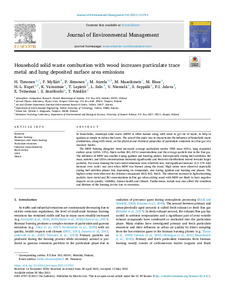Household solid waste combustion with wood increases particulate trace metal and lung deposited surface area emissions
Timonen, H.; Mylläri, F.; Simonen, P.; Aurela, M.; Maasikmets, M.; Bloss, M.; Kupri, H. L.; Vainumäe, K.; Lepistö, T.; Salo, L.; Niemelä, V.; Seppälä, S.; Jalava, P. I.; Teinemaa, E.; Saarikoski, S.; Rönkkö, T. (2021-09-01)
Timonen, H.
Mylläri, F.
Simonen, P.
Aurela, M.
Maasikmets, M.
Bloss, M.
Kupri, H. L.
Vainumäe, K.
Lepistö, T.
Salo, L.
Niemelä, V.
Seppälä, S.
Jalava, P. I.
Teinemaa, E.
Saarikoski, S.
Rönkkö, T.
01.09.2021
112793
Julkaisun pysyvä osoite on
https://urn.fi/URN:NBN:fi:tuni-202106226020
https://urn.fi/URN:NBN:fi:tuni-202106226020
Kuvaus
Peer reviewed
Tiivistelmä
In households, municipal solid waste (MSW) is often burned along with wood to get rid of waste, to help in ignition or simply to reduce fuel costs. The aim of this study was to characterize the influence of household waste combustion, along with wood, on the physical and chemical properties of particulate emissions in a flue gas of a masonry heater. The MSW burning alongside wood increased average particulate matter (PM) mass (65%), lung deposited surface areas (LDSA, 15%), black carbon (BC, 65%) concentrations and the average particle size in the flue gas. The influence of MSW was smaller during ignition and burning phases, but especially during fuel additions, the mass, number, and LDSA concentrations increased significantly and their size distributions moved towards larger particles. For wood burning the trace metal emissions were relatively low, but significant increase (3.3–179 -fold increase over cycle) was seen when MSW was burned along the wood. High ratios were observed especially during fuel addition phases but, depending on compounds, also during ignition and burning end phases. The highest ratios were observed for chloride compounds (HCl, KCl, NaCl). The observed increase in light-absorbing particle, trace metal and BC concentrations in flue gas when adding wood with MSW are likely to have negative impacts on air quality, visibility, human health and climate. Furthermore, metals may also affect the condition and lifetime of the burning device due to corrosion.
Kokoelmat
- TUNICRIS-julkaisut [16929]
